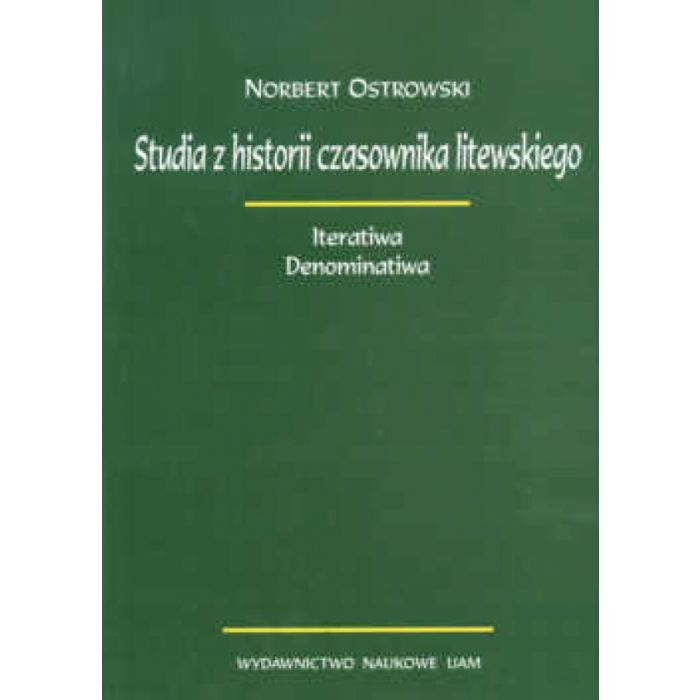Studia z historii czasownika litewskiego. Iteratiwa. Denominatiwa
- In Stock: in stock
- ISBN: 83-232-1646-0
- Category: OUTLET, Linguistics
- Year of publication: 2006
In contemporary Lithuanian there are some morphemes which express the iterative meaning of the verb. But only one of them, the suffix -yti, is Indo-European heritage. The other ones are Baltic or Baltic-Slavonic innovations. Especially noteworthy is the Lithuanian iterative suffix -e`ti that originates from preterits in -e^- of Baltic causatives with present stem in -ja- such as pres. ródzia, pret. ro`dé 'show' or pres. vei"sia, pret. vei"sé 'breed'. In short: pret. in -ë- + suffix -já- -> pret. -é-ja~- -> pres. -ë-ja~-, inf. -ë-ti. The explanation of inherited resultative verbs in -éti (e.g. ture`ti 'habe; must') has so far been misconceived as historically identical with the iteratives in -eti. Iterative meaning of the suffix -ja- suggests it served in Baltic as morpheme of imperfect tense. As a form of the imperfect in Indo-European was built on the ground of the present stem (cf. the imperfect in Old Greek) the Baltic one must be an innovation, parallel to Old Church Slavonic, cf. aor. pbs-a-xb -> imperf. pbs-a-axb. On the ground of the preterite have been built, among others, iteratives with zero grade vocalism, e. g. Lith. kilóti (Latv. cilät). In the Baltic languages one can notice the transition from iteratives to causatives and vice versa because of reinterpretation of derivatives to their basic words. The iterative verbs can be interpreted as causatives (e. g. Latvian causatives of the type mërdët) and causatives as iteratives (e. g. Lithuanian iteratives in -styti). The process is old, cf. the causativisation of the IE iteratives with suffix -eye- in Old Indie.
- Przedmowa
- Skróty
CZĘŚĆ I. Z HISTORII ITERATIWÓW LITEWSKICH
- 1. Litewskie iteratiwa na -(d)eti
- 1.1. Opis synchroniczny
- 1.2. Iteratiwa na -(d)eti w starolitewskim
- 1.3. Pochodzenie iteratiwów na -(d)eti
- 1.3.1. Bałtyckie iteratiwa na -(d)eti
- 1.3.2. Czasowniki typu pakyleti
- 2. Łotewskie causatiwa na -(d)et
- 3. Uwagi na temat bałtyckiego aorystu i imperfectum
- 3.1. O iteratiwach typu litewskiego kilóti i łotewskiego cilat
- 3.2. Geneza bałtyckiegu sufiksu -ja-
- Ekskurs I. Litewskie pażinti, paljsta, palmo
- 4. Bałtyckie formacje czasownikowe zbudowane na bazie czasu przeszłego
- 4.1. Czasowniki litewskie na -inoti (łotewskie -inat)
- 4.2. Litewskie ingressiwa typu isgirsti i prabilti
- 4.2.1. Znaczenie przestrzenne przedrostków is- i pra-
- 4.2.2. Powstanie ingressiwów z pra- oraz iś-
- Ekskurs II. O prywatywnym ap- w języku litewskim
- 5. Litewskie czasowniki na -(d)ineti
- 5.1. Problem aspektu czasownikowego w języku litewskim
- 5.2. Starolitewskie iteratiwa na -(d)ineti
- 5.2.1. Iteratiwa : duratiwa
- 5.2.2. Pochodzenie sufiksu -(d)ineti
- 5.2.3. Fuzje sufiksów w czasowniku litewskim
- Ekskurs III. Curatiwa litewskie na -dinti
- 6. Czasowniki litewskie na -C'oti (łotewskie -C'at)
- 6.1. Czasowniki litewskie na -(ś)ćioti
- Wnioski
- 1. Litewskie iteratiwa na -(d)eti
CZĘŚĆ II. Z HISTORII DENOMINATIWÓW LITEWSKICH
- 7. Denominatiwa litewskie na tle indoeuropejskim
-
- 7.1. Litewskie denominatiwa na -eti
- 7.1.1. Inchoatiwa na -eti
- Ekskurs IV. Refleksy systemu Calanda w językach bałtyckich
- 7.1.2. Factitiwa na -eti, -eja-, -ejo-
-
- 8. Czasowniki litewskie na -yti, -ija-
- 9. Czasowniki na -enti
- Ekskurs V. Sufiks posesywny -Hon- i substantywizujący -en-/ -on- w litewskim
- Ekskurs VI. Słowiańska rózga i litewskie razgal
- Wnioski
- 7. Denominatiwa litewskie na tle indoeuropejskim
- Bibliografia
- Słowniczek niektórych terminów użytych w pracy Indeks wyrazów
- Studien żur Geschichte des litauischen Verbums. Iterativa. Denominativa (Zusammen-fassung)
| Detailed information | |
|---|---|
| Publication Version | printed |
| Format | 17,0 x 24,0 cm |
| Title (EN) | Studies in the history of a Lithuanian verb. Iteratives. Denominatives |
| Type of publication | Monografia |
| Edition | I |
| Series | Językoznawstwo Stosowane nr 25 |
| ISSN | 0239-7617 |
| ISBN | 83-232-1646-0 |
| Number of pages | 175 |
| Number of publishing sheets | 13,00 |
| Type of binding | paperback |
